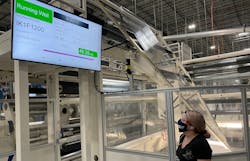Strategic Analytics Help Intertape Polymer Shrink Inefficiencies
Editor's Note: Intertape Polymer Group's Jai Sundararaman, IPG vice president of business transformation. will be speaking at the upcoming 2021 Manufacturing & Technology Show, Nov. 9-11 in Cleveland, Ohio. His topic: Leading Your Digital Transformation with Business Impact.
For Intertape Polymer Group (IPG), a global manufacturer of packaging and protective solutions for industrial and e-commerce applications, the digital transformation process has always been about embracing technology with a keen eye on extracting the overall business value. As such, IPG is currently at different levels of maturity across the portfolio of digital technology deployments, including additive manufacturing, AR/VR training, IoT-based predictive downtime and robotic process automation.
However, IPG is prioritizing the scale out of an end-to-end consolidated analytics platform across nine plants, drawing off successes at the Tremonton (Utah) plant pilot, explains Jai Sundararaman, IPG vice president of business transformation, who is leading the company’s global digital transformation, operational excellence and innovation initiatives.IPG’s data approach
Data analytics garner significant attention – and whether manufacturers see a return on investment often depends heavily on their approach. Why? Simply put, data analytics have become the current day version of snake oil. There are a lot of shiny, black box options available, many sporting mesmerizing dashboards with beautiful graphs intended to give leadership a view into what is happening out on the plant floor.
Unfortunately, these systems are not all created equally, especially when it comes to providing actionable insights. “For meaningful insights, the data needs to be right, and there need to be solid models,” he says. “It's not always going to be a quick win. And you need to be able to trust partners to come up with the background analytics framework.”
For IPG that partner is Sight Machine, who not only offers manufacturers a set of tools and capabilities to draw analytics and insights, but also provides support with the required data scientists and the analytic capabilities in the backend.
This was vital for Sundararaman, because as he tells IndustryWeek, IPG is not in the business of AI. “We are in the business of making quality products using world class assets. Our strengths are in manufacturing, engineering and operational excellence,” he says. “Data, if it is provided with the right kind of framework, will still have to be interpreted by the process engineers and the operators to take advantage of the insights. This is where instead of the army of scientists, we can double down on investments in process engineering. It doesn't mean that we're not hiring data scientists, but with the right platform we do not need to hire an army.”
Instead, IPG has taken advantage of the unique data modeling capabilities of the Sight Machine platform, which continuously transforms all data types generated by factory equipment and manufacturing software into a robust data foundation for analyzing and modeling a plant’s machines, production processes and finished products.
Sight Machine enabled IPG employees, from the shop floor to its executive offices, to monitor real-time performance, troubleshoot problems and capture quality issues early in the production process. While IPG initially identified five use cases leveraging Sight Machine’s out-of-the box tool capabilities, the plant engineering and operations team has since expanded the use cases to 35 with support from Sight Machine. Alexander Soave, Sight Machine senior continuous improvement manager, describes the Tremonton work as “a massive Kaizen project” that organized, analyzed and visualized newly available data to identify efficiency improvements and fix problems across the entire process value stream.
Natural selection
When selecting use cases, Sundararaman sought input from the team and listened intently to the stories. "The goal was to identify where processes are not measuring up, and where opportunities existed for yield improvements, scheduling improvements or eliminating downtime," he says. "We were also looking for use cases we could standardize across different plants."
Addressing yield management on a production line quickly surfaced as an ideal use case. Prior to deploying an analytics platform, experience-based knowledge was crucial in keeping its processes streamlined and center-lined despite hundreds of variables. Unfortunately, that type of knowledge transfer is difficult to realize. “In many instances human judgment was good enough to maintain through the variabilities – but only good enough,” he says. “The application of data analytics proved to be the home run in better accounting for variabilities, and we have sustained the benefits for the last three quarters.”
Even better, the success of line optimization now serves as an anchor use case IPG is applying across all its facilities.
Capability building is crucial, but not only from the analytic side. “We know our processes, we know our machines, but we didn't know what else we could do with this kind of data or what kind of insights we could draw. According to Sundararaman, IPG’s mantra from a digital transformation perspective is to empower employees with technology and insights. This happens at different levels.
- Planning. IPG is primarily starting off its data initiative with process engineering and operational leaders, with the goal of cascading it down to the frontline. “Where the frontline operator sees the changes, that's going to impact things in the future,” he says. “It's already starting to happen, and we want it to cascade across all the people in the plant.”
- Learning. “We are still crawl, walk run. We are scratching the surface from an opportunity standpoint, which is the data that currently exists,” he says. “We need to continue contextualizing existing data before we enter into predictive analytics or machine learning. However, the goal is to move into the predictive side within the next two years.”
- Expanding. As IPG starts rolling data-based learnings out across different plants, it should be able to compare best practices in a very objective insight-based analytics space, rather than the relying on the operator's or the engineer's best estimate of what's really going on. “We have machines spread out globally all with similar processes,” he says. “Currently, there is not an easy way for us to account for and articulate the difference in variabilities impacting different plants. But now we have the tools and insights to be able to go into those areas.”
‘People don’t know what they don’t know.’
The data successes at IPG’s Tremonton plant serve as a prime example. The plant is not an instance of a facility ripe with inefficiencies where digital deployment can immediately attack the low hanging fruit and boast about instant successes.
Instead, this is a plant that has already addressed its quick wins. The plant has fully embraced the concepts of operational excellence and lean implementation. In fact, it won the IndustryWeek best plant designation in 2017, and it is once again a finalist in 2020. “Now we are applying a comprehensive analytics platform to significantly improve yields on a plant that was already a best-in-class facility,” he says. “It opens a completely different way of thinking.”
The key to success moving forward? According to Sundararaman, there needs to be a distinct focus on change management and capability building. “When embracing analytics, you're enabling certain opportunities, but you need to build capabilities to extract the value. You need to be able to draw upon the strengths of the company,” he says. “In our case, that is process engineering, continuous improvement and leadership support especially in terms of problem solving.”
Sundararaman continues, “If you're a lean student, you know to go to 'gemba,' but doesn't mean that you don't look at the data. However, you're looking at data in a completely different way,” he says. “You are going to gemba with the data with a focus on understanding what the data is saying.”
Once IPG fully embarks on its global rollout, it will be able to compare, contrast and incorporate best practices grounded in data analytics, rather than best guesses. “We will be able to take into account how the humidity factor plays an impact for Danville versus Portugal, or how they go about with their settings,” he says. “Now we could really look into the inner workings and compare all the variables that go on into making the quality product.”
About the Author
Peter Fretty
Technology Editor
As a highly experienced journalist, Peter Fretty regularly covers advances in manufacturing, information technology, and software. He has written thousands of feature articles, cover stories, and white papers for an assortment of trade journals, business publications, and consumer magazines.


